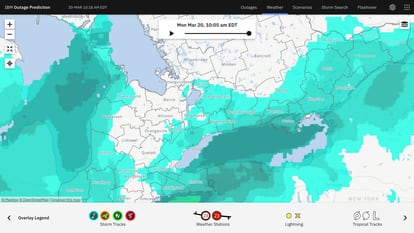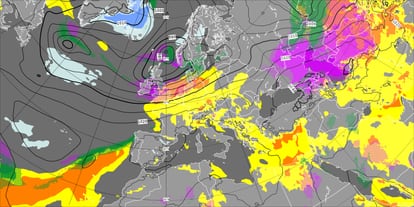The consequences of efficient weather forecasting go far beyond planning a vacation. Having accurate data over a long period of time, beyond the three days currently assumed by the most reliable estimates, would save lives and avoid economic losses that a study published in nature communications figure at 143,000 million dollars annually (131,565 million euros). Technological giants such as Google or IBM, in collaboration with NASA, and institutions from the EU and other continents, have joined the objectives of the United Nations plan to improve early warning systems and develop tools to take advantage of advances in artificial intelligence in order to achieve reliable prediction in the medium and long term. Understanding the sky is one of the scientific and technological challenges of our time.
Storms, floods, droughts, heat waves, hurricanes and other extreme weather events each year represent billions in costs, most of which (63%) correspond to the evaluation of human losses, according to the study by Nature led by New Zealand researchers. Understanding these adverse events and anticipating them is essential and has become a key objective of the technology agenda.
Google DeepMind, the artificial intelligence company of the North American technology giant, has published in Science a machine learning-based weather forecasting model to provide 10-day predictions “better, faster and more accessible than existing approaches,” according to the study. The model, called GraphCast, outperformed traditional systems in 90% of the cases tested.
Compared to current numerical data analysis models that use expensive and complex computational resources, GraphCast uses machine learning trained from historical data to provide an accurate 10-day forecast in less than a minute. “We believe this marks a turning point in weather prediction,” say the authors, led by DeepMind scientist Remi Lam.

In this race there is also IBM, in collaboration with NASA, with a proposal, also of machine learning based on the founding model (trained with a wide spectrum of unlabeled data) geospatial of the technology company. This approach allows you to analyze millions of general data to perform different tasks.
“Foundational artificial intelligence models that use geospatial data [meteorológicos, de sensores y de satélite] “They can change the rules of the game because they allow us to better understand, prepare for and address the many climate-related phenomena that affect the health of our planet in a way and at a speed never seen before,” explains Alessandro Curioni, IBM vice president for Europe and Africa and director of the company's research center in Zurich (Switzerland).
The program has already been used to analyze urban heat islands to reduce thermal stress by up to three degrees Celsius and to plan a 15 billion tree reforestation campaign in Kenya in the next decade. Also being studied, with the Scientific and Technological Facilities Council (STFC) of the United Kingdom, is the impact of extreme weather on aviation operations and infrastructure and a project for the natural restoration of forest masses that prevent flooding. This already has a pilot experience in Glasgow.
For Kate Royse, director of the STFC's Hartree centre, these models “enable smarter decisions based on the accurate prediction and management of flood risk, which is essential for the future planning of cities.”

“We are dramatically facing the accelerated effects of climate change. We need to better mitigate and prepare for these events. “AI could help with that,” he warns in the European research publication horizon the professor at the Polytechnic University of Milan Andrea Castelletti, expert in natural resource management
Catelletti agrees with the approach of the computer giants in that current prediction models are based on algorithms to analyze large amounts of data without achieving optimal precision. “They still have weaknesses,” Castelletti admits, stating: “Artificial intelligence could solve them.”
“Existing climate models are not very good for certain extreme weather events. Heat waves in Europe, for example, are increasing much faster in the real world compared to what models tell us should happen. It is important to forecast extremes so that we can have early warnings,” agrees Dim Coumou, a climatology expert at the University of Amsterdam
(Netherlands).
CLINT, An EU-funded research project in which Spain participates combines artificial intelligence with data from the European Copernicus satellite network to improve climate prediction. He European Center for Medium-Range Weather Forecasts, like IBM and Google, it is also applying machine learning in its programs.
Another European project called XAIDA, and in which Spain also participates, attempts to understand the underlying causes of extreme weather events. “It is about understanding the role of climate change in phenomena ranging from heat waves to droughts and extreme rainfall. We want to know the determining factors,” explains Coumou.
Adverse and rare phenomena
One of the obstacles to achieving this precision is the information available to train artificial intelligence. Although it seems that information exists for decades, it may not be relevant to understanding the most adverse events. “Extreme events are, by definition, rare. So you don't always have many observations. That is a big obstacle if you want to use artificial intelligence methods,” details Coumou.
In this sense, the CLINT project aims for AI systems to be the ones that generate this data from historical information and that these allow machine learning to be trained to improve predictions.
Some initiatives focus on specific phenomena to advance precise forecasts. It is the case of CRUCIAL laboratory from the universities of Lancaster and Exeter, in the United Kingdom, which attempts to determine the number of hurricanes in the Atlantic in 2024.
“Changes in ocean temperatures, driven by climate change, mean that the historical hurricane record is no longer a good guide to predicting future hurricanes,” he says. Kim Kaivantoprofessor of Economics and member of the CRUCIAL initiative.
Likewise, researchers from Korean Institute of Civil Engineering and Construction Technology (KICT) have developed a system to forecast flash floods one hour in advance. Geon-Wook Hwang, a researcher at this institute, explains: “A forecast, even if accurate, has no value as information if it does not arrive soon enough to significantly reduce casualties and property damage caused by flash floods.”
You can follow SUBJECT in Facebook, x and instagramor sign up here to receive our weekly newsletter.
Subscribe to continue reading
Read without limits
_
#race #achieve #reliable #longterm #weather #predictions